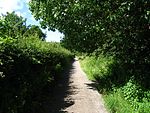Ashton Park, Merseyside
Merseyside geography stubsParks and commons in the Metropolitan Borough of Wirral

Ashton Park is located in West Kirby, Wirral. The park is bisected by the Wirral Way forming an upper and lower park. Facilities at the park include a lake, playground and café with toilets in the lower park and tennis courts, a basketball court and a football pitch in the upper park. There are also two crown bowling greens; the Upper Park Green is used by West Kirby Ladies Bowling Club and the Lower Park Green is used by West Kirby Victoria Bowling Club. The south end of the lake is used by Wirral Model Boat Club. Each year a May day fair is held and in the summer local bands play in the Upper Park Arena.
Excerpt from the Wikipedia article Ashton Park, Merseyside (License: CC BY-SA 3.0, Authors, Images).Ashton Park, Merseyside
Westbourne Road, Wirral
Geographical coordinates (GPS) Address Nearby Places Show on map
Geographical coordinates (GPS)
| Latitude | Longitude |
|---|---|
| N 53.3709 ° | E -3.1811 ° |
Address
Westbourne Road 32
CH48 4DH Wirral, Grange
England, United Kingdom
Open on Google Maps









